In wall light switch node - Custom PCB
-
@samuel235 you understand correctly

-
I have added a ISP header, 100uF cap through-hole footpads, i may remove one of the two 47uF caps, don't feel i will need two 47's and a 100, i'll keep the pads there for it but wont add it just yet.
I'm now just playing around with the layout of the board, at the moment i have it down to around 1.2inches by 2.8inches. It would be alot slimmer if i didn't have a 24mm batt onboard. However i don't want to be changing the battery every month, so i opted for the bigger size of the batteries. Once i have the layout, i'll do some drawings and models of this to enable me to see if it will fit my application.
The RF module is adding to the overall size because i'm trying not to have it mounted over the top of anything as adviced to reduce chance of interference.
I will get some images up tomorrow for an update to this build log.
-
Current situation:
I'm really struggling with the composition of the board to enable me to fit this into the slim socket back box, I'm now giving it a thought to mount the radio over the board. However this is still coming VERY tight to fitting, mainly because of the size of the switch i have chosen, it extrudes quite a way back into the box (as shown in the Sketchup model in the original post, at the top of this page). I only have 11mm behind the middle of the box, the battery mounted plus the board and plus 5mm mounted capacitor (applicable in the first image shown below where the radio is overhanging the edge of the board) would equal around 12mm, so even at an angle i don't think this board would fit in there.
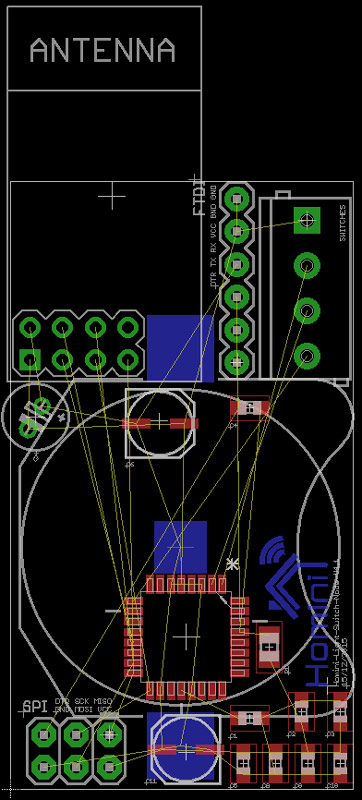
So that is why i looked at the idea of moving the cap out of the way to the other side of the board, putting the radio down onto the bottom of the board but keeping its orientation. I think this may reduce the thickness of the overall package slightly, will still be very tight (within 1mm i think), but a possibility it would fit (maybe). Shown in the design layout below. I think if i could remove the black plastic standoffs on the header for the radio and mount it practically touching the board itself then i may have a chance to get it in.
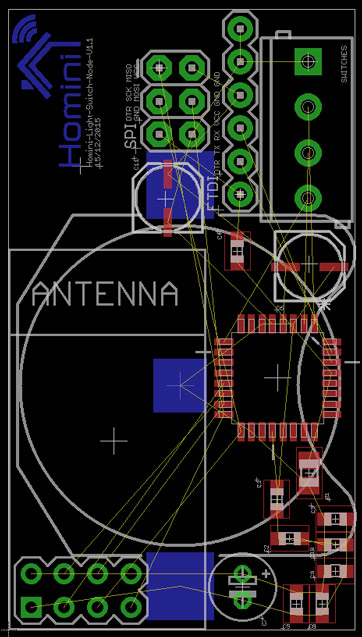
First of all, do you think that there would be any issues with the layout i have placed in the second design? As far as I can see i have done the main things like keeping the caps next to what they are intending to protect, kept under the radio board clean, have 1 x 100uF cap for spikes on radio and 2 47uF cap's for additional large spikes, 0.1uF caps are dotted around the bottom to reduce small spikes, managed to get a SPI and FTDI header included with all the resistors and caps needed.
The last few days I'm sitting at the stage of just rearranging the design to fit into my environment, I may have to change the backbox if needed but i would prefer to manufacture the board to fit into the smaller space if possible. but if physical limitations are there that is impossible to work around it would leave this as the only resort.
-
As the night draws to a close, it would appear i have found the physical sizing issue solution! Now, just for the routing to be done. Another stage, another day! As this project gets closer to a completed board, the more I get excited about the manufacturing of my first ever useful custom made PCB. After all, this is what a community built project is all about, experienced users helping armatures become experienced to help armatures, isn't it? I'd like to just take this post to thank everyone that assisted me so far with this project!
The remaining steps:
- Add MySensors' logo/branding to the board.
- Complete the routing of the board.
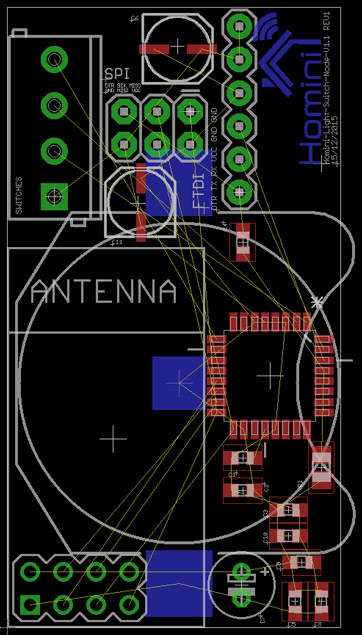
-
Good morning guys, just to keep the topic updated with the latest info on this project;
I'm still currently designing the board, trying to move parts around and route the traces. Because of everything being so cramped I'm having a real hard time getting this done. I'm having a couple of issues here where i can't get traces from certain points (top left corner) out and around the through-hole components so i will need to be moving some things around again, but I'm constantly pushed on a cramped space to physically get this into the light switch. One of the biggest issues i have is the terminal block, I may remove this and just end up soldering the switch cable directly to the board. The other issue i have is a software issue with eagle and ITead manufacturer, I'm creating routes with >8mil thickness (the website says that 6mil is minimum), then using their checking DRC file, and its throwing back errors relating to the trace width, however if i create the traces in 10mil its fine. However, there is just no way at all i can get away with 10mil

Today's agenda:
-
Remove screw terminals.
-
Relocate the micro controller under the nRF board, not under the antenna section though.
-
Relocate some of the components around the top of the board to allow traces through.
If i could get some feedback from you guys on the following, it would be appreciated.
-
Do you think I might be able to route/trace on the bottom layer under the antenna section (Antenna will be sitting about 2-5mm above the top layer) without receiving interference.
-
What do you think about my DRC Check errors? ITead say >6mil but i get errors on 8.5/9mil.
-
-
hi @samuel235 Check the rules spacing between traces. Trace width needs to be minimum 6 mil, but space between traces also has a minimum, maybe this is set higher ? I have used this DRU file and so far always had good boards from manufacturers.
Gert_Sanders.dru
Maybe this helps your tracing issue.
-
Good evening @GertSanders - There is nothing else on the board, I'm literally testing this on a clean board file, nothing on it at all. Just 1 wire. So there for there is essencially nothing to make a spacing issue around the wire. I have just tried to do it on any other layer than top or bottom and it doesn't create an error.... Is there any area of the DRC checks that only apply to the width of the top/bottom traces?
-
hi @samuel235 Beats me, if there is only 1 wire then maybe you have a conflict between the net class and the DRU. But I do not know what would be the issue without trying the same DRC check on your board file.
-
@GertSanders - I have just tried your DRU file, its doing it for that too.... Your minimum width and spacing is set to 6mil, i've ran my routes in 8 and 12.
EDIT: Turns out you were correct in advising the net class conflict, i went into the net class editor and it is set to 12mil so i changed this to 6 to double check, and it works perfectly. Can i leave this at 6 without any issues or is it there for a specific reason? I'm going to have a little research on these net classes because i honestly don't understand their purpose when they are set to a value above that of a custom DRC check.
-
hi @samuel235 The netclasses allow you to differentiate trace widths and spacing automatically when using the autorouter. If you do nothing, then all traces are routed by the autorouter according to the DRU. In the Netclasses you can overrule the default trace width and spacing to be respected by the autorouter.
When you check a trace (checking it's attributes) you can see to which net class it belongs. It is mentioned at the bottom.
Why different netclasses ? For example if you use power lines on your board, you could want them to be wider and have more clearance from other wires. To be able to check that the extra clearance is respected, you can define extra clearance in a net class called "power" and then make those wirelines for the power net member of the net class "power". If you use the autorouter, and you defined a width of 20mil for the power net, then the autorouter will make those traces 20mil wide. If you defined a clearance of 15mil for the power net, then all traces different from that power net need to be routed at least 15mil away from the power trace (e.g. Vcc signal or GND signal). If you trace by hand, then sometimes one could be tracing a signal line too close to a power line, and when doing a design rule check, the net class limitations are taken into account.
-
@GertSanders I think I explained incorrectly, i understand that the net classes are for the autorouter and how you can tell the auto route to do different classes for different instances. But what i don't understand is why if i have manually routed everything, why is the drc checker using the values on net classes, is it just as simple as changing the net classes to the board houses specific requirements?
Also, would there be a way to create different profiles for the net classes for each board house, just like how you can create different drc files for different needs?
-
@samuel235 If a DRU file species that two signals need to be a minimum of 6mil apart and the net class requires that different signals need to be 8mil apart, then the larger spacing is what counts. If your default net class has a larger spacing minimum then the DRC of a board house, then you need to follow the net class definition when doing manual routing. Autorouting takes into account the most stringent requirement automatically.
You can have several DRU files, but I do not know if you can link them to specific netclasses.
-
@GertSanders Ahh okay, that makes complete sense now. So the default is set to Width: 10mil, Drill: 20mil, Clearance: 10mil. ITead specify Width: 8mil, Drill: 0.3mm, Clearance: 8mil, I took these figures from here.
So I am safe to change my net classes to those of the board house to run the checks and then revert them back once i generate my gerber files? Or have i miss understood?
-
@samuel235 You can change the defaults to the values of the boardhouse and leave it at that. When generating the GERBER files, the DRU or net class values are no longer important. You only need the values when checking against design rules.
-
@GertSanders said:
@samuel235 You can change the defaults to the values of the boardhouse and leave it at that. When generating the GERBER files, the DRU or net class values are no longer important. You only need the values when checking against design rules.
Awesome! I shall get it checked and posted here in a minute and hopefully I'll get it ordered tonight

-
And the final designs are shown below. As you can see the one on the left is without the ground planes and the one on the right is with them. If anything is jumping out in terms of errors or discrepancies, please don't hold back, let me know

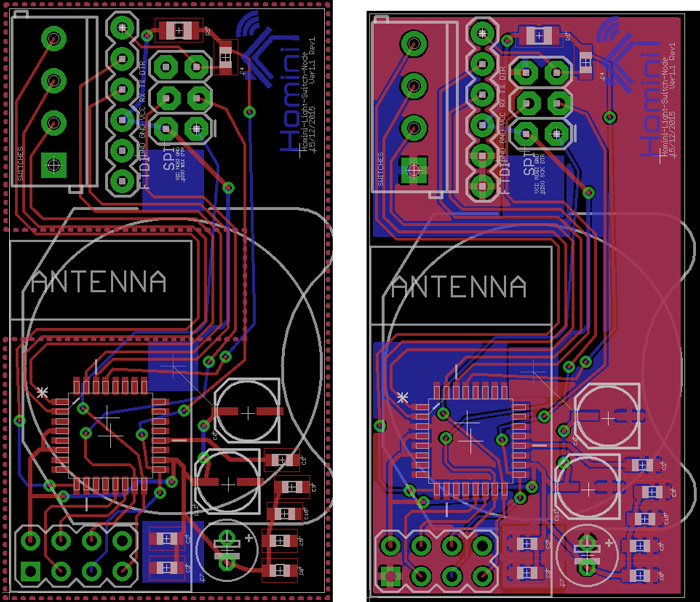
-
UPDATE!
Just a little update to keep you all posted; I have sent my Gerber files off, they have been confirmed to be of the correct format and my boards are now being produced. I ordered the parts last night, enough for backups/errors, soon as everything arrives i will get this made up and give you another update on the situation of the board. The only thing i wasn't comfortable with was the price of the screw terminal and the fact i used a through hole capacitor for the 100uF (C7). The next revision of the board i will be using a surface mount 100uF capacitor for this, now i managed to find it. The terminal for the switches, I'm looking at maybe having a crimped push connector on the switch that just slots onto some sort of header pin on the board instead of a screw terminal.
Either way, Homini Light Switch Node Version 1.1 Revision 1 is on its way!
-
I have just received confirmation that the board house has released the PCB's. Lets see how long these take to get here! Itching to get this module on the move again. I will be back soon as they get here, don't go anywhere!
-
UPDATE!
I have just received all components for the boards, we're just waiting on the boards themselves to arrive from ITead Studios.
Time to get this project moving!
-
While waiting for my boards to arrive i decided to create a housing for my gateway including flashing status LEDs. Its in no means a finished product, but i feel its enough to house the gateway components while i'm building my network to save any incidents destroying the parts. Within the next few days i will get a guide up with images and maybe a video of the LEDs and their function up on a hardware guide topic.
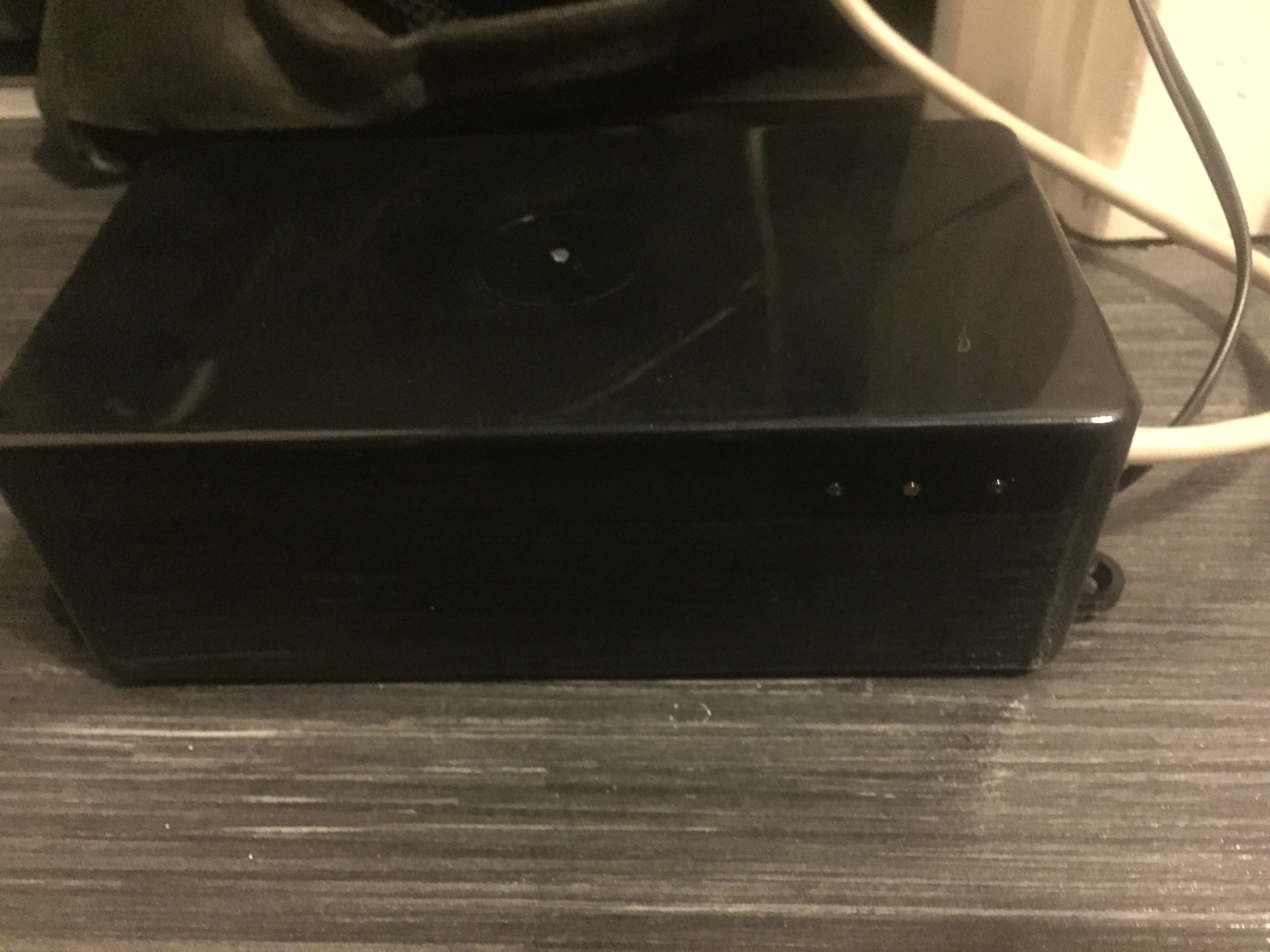
-
So then, we have another update!
UPDATE!
The boards ave arrived safe and sound, i have populated one of them with everything apart from the nRF module. So, its time to get the bootloader burnt. This is the daunting task for me, i have no idea what i am doing here, so if you guys feel like you could give me some helpful pointers in the right direction I would really appreciate all the help you can offer.

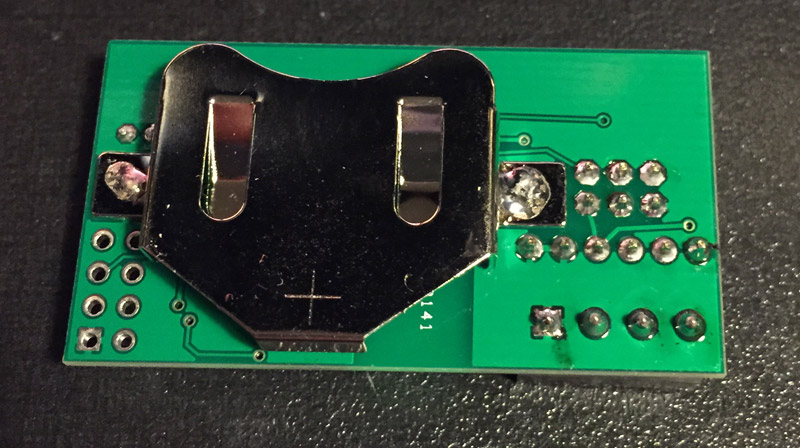
-
Hi! Depending on which bootloader you want, but why not go with the MySensors with OTA updates by tekka?
http://forum.mysensors.org/topic/838/windows-gui-controller-for-mysensors/75If you want the original arduino bootloader: https://www.arduino.cc/en/Hacking/Bootloader?from=Tutorial.Bootloader
-
@sundberg84 - I was reading that exact post from tekka as you posted this. However, i'm probing around on my board and found for some reason my 3v line is 0.24v. So I have to do some investigation work on that this morning. Hoping the bootloader will be a piece of cake once the hardware is working as should be.
-
@sundberg84 So i have my hardware issue corrected now. Am i reading Tekka's instructions correctly, this new board is to be connected through serial to my gateway and then programmed essentially by the gateway through MYSController which is connected to my gateway via ethernet? Does that sound correct?
-
No, i would recommend you have a look at some youtube tutorials. Im not familiar with programming through the ISP headers which i think you should do. I use a seperate arudino uno as ISP programmer.
-
@samuel235: cool. happy for you.
first you need to burn the bootlader in your atmel 328p. When it comes as ic-only, factory setting is 1mhz internal rc. and there is no bootloader yet. So you can't use ftdi at this moment, nor ota. So you need to burn the bootloader with avrspi. Like @sundberg84 said you can use the "arduino uno as isp programmer" method if you have an uno..On my side, I don't use this method, I prefer to use an usbasp. But both method works well.
When burning bootloader, you will need to set fuses too, corrsponding to the bootloader.Sorry, I have not much time to make an howto, just point you in some direction..i hope it helps a little bit.
Edit: you can find some howto here http://www.gammon.com.au/breadboard
-
@scalz I'm using a USBasp programmer, however i think i may have an issue with my reset pin. I have continuity on every other ISP header pin and the associated pin on the ATMega but not the reset pin. Is this normal, should i be seeing continuity between ISP RESET and pin 29 on the ATMega?
-
I think you should have continuity between avrspi connector RST pin and your atmega RST pin...don't see why not. Have you checked your routing? I think so...Maybe a bad solder on this pin???
-
@scalz I may have found the problem, i have just completed a x25 magnification inspection on the boards and every board has atleast one filled VIA. I'm going to get a makeshift jumper in place on this board and test for continuity again.
I get continuity from the pin to the one side of the capacitor but nothing from the MEGA to the pin, it feels like the capacitor is stopping it coming through...
-
oki, so if continuity between rst atmega and one side of capacitor (dtr ftdi capacitor, right?) it should be ok. The capa is for dtr of ftdi (it is a trick for resetting atmega from ide when you want to upload).
Is your schematic updated on your first post? I don't see a 10k resistor pullup for rst...you need it to keep rst line to 1 and then when you push a rst button, or want to reprogram it by ftdi or avrspi, it will go to low/0 briefly to tell the mcu to reset.
if not done, try to connect a 10k res between your rst pin and vcc
-
@scalz I have just uploaded a zip file with my .brd and .sch files. Sorry, forgot to update those
-
oki seems good. so I imagine you have continuity between rst atmega/one side of the 10k res. so what is your problem to program it?
when programming with avrspi, be careful with the fuses, especially for clock freq. For instance, if you set the clock fuse for external crystal and you have no onboard, then you could have some problem to re-set the fuse to internal clock as at this moment, the mcu will wait for an external clock. I am not sure as I have never tested this, and I am careful when I set the fuses, but in eventuality I am tired and make a mistake, I like to put a crystal footprint. but sometimes, you have not enough room unfortunately.
-
@scalz I get continuity from the ATMega to the resistor and one side of the cap. But its not flowing through the cap. So you think i should be good to program from there? I try to test a connection to the board with AVRDude, by running "C:>avrdude -c usbasp -p m328p" and then i get
avrdude: error: programm enable: target doesn't answer. 1 avrdude: initialization failed, rc=1 Double check connections and try again, or use -P to override this check. avrdude done. Thank you.
-
yep, for capa it is not a problem. so it should work, but your log seems indicating a connection problem...but I don't see it
 and I don't have much time for the moment...sorry.
and I don't have much time for the moment...sorry.
for avrdude cli, I can't help you as I use avrdudess. no need of cli, a little bit easier.
-
@scalz While feeding the board 3v, every part of the VCC line from the battery to the chip is perfect, however if i test a VCC pin and a GND pin on the chip, it reads 0.06. Would this be an issue?
Maybe i should have connected all of the vcc's together or even pulled another to the battery directly, the only vcc connection going to the mega is from the DTR/RESET pin on the SPI header, that flows through the resistor to the mega. Is this an incorrect wiring issue?
-
Okay, so for some reason i seem to have not connected all the VCC's together unfortunately, i personally believe this is where my issue lies. If anyone feels differently, please shout out and let me know.
-
@samuel235: i have just looked briefly to your .brd this time
 .So, for your next rev:
.So, for your next rev:- you have airwire. You have to have no airwire at all or you must know what you do. Here you have an airwire on your batt which is not connected to mcu. So of course it can't work. You can fix this by soldering a wire between Batt_vcc and radio_vcc. it should work. Sometimes, when board is complex, you can't see everything, and sometimes airwire are micro..in eagle you can see these : File menu/run ulp/ and launch zoom_unrooted.ulp. It will highlight these.
- decoupling capa, which are not always mandatory, but for a mcu I would say yes, needs to be placed near the concerned chip. Your board is small so it should work. but it's something to know.
- for vcc, power line/rails, you are using 12mil (trace width I usually use mils unit as I am not familiar to inch! I'm french lol). I think it is rather small...For signals, it's ok. But for power, hum..I prefer not to go under 16mil and it's my limit. I like 20/24 or 32mils, all depends of the current.
As you can see, pcb design is a whole science! I would advise you to persevere, you will find very good starter howto for pcb designing at sparkfun. they rocks! adafruit too. It's like kung-fu, I like to say : the path/road is long
 but finally it's very rewarding, yeah
but finally it's very rewarding, yeah 
-
@scalz - While you were away i noticed about the VCC line not getting to the Mega, so i soldered a wire from batt + to the nRF vcc, like you just confirmed.
I would too prefer the traces to be bigger, however I routed them with a bigger size but i couldn't route the board completely. So i chose to bring the size down hoping to get away with it.
So, i have made the connection with the additional wire and I'm still unable to get a test communication connection to the board through USBasp. I thought maybe its going a little too quickly for the board and so i decided to use a slower SCK speed, dropped it really low, still nothing.
-
arf..and now what's your vcc voltage?
if I have an idea, I'll tell you
-
@scalz I'm sorry, you have confused me with arf, what does arf mean? Is it some 'slang' word? xD - My vcc voltage is 3v from a battery, if i let the USBasp power it, i set it to 3v which comes out at 3v3.
-
ahah. it was an onomatopia? a sort of "argh" or "gloups". I don't know how to translate it lol!
for your vcc problem (seems now you have a true one), there is of course an answer but I have no idea for the moment...like I said if I have one I will tell you. I will try to re-look at your eagle files maybe tonight...
-
@scalz Ahh okay, i assumed it was to be honest but just in case it was some sort of technical term that i didn't understand i thought it was best i questioned it.
Yeah, i have some power in the chip now it seems, thank you for shining some sort of light on one issue, whether it is the issue that is stopping it from working or not, its help at least. When i get home i will be spending some more time on troubleshooting the issue again. Hope to speak to you later

-
@scalz I've woken this morning quite ashamed at the fact last night/yesterday i must have been that sleep deprived when asking about continuity over a connected capacitor. They will only show continuity if they are blown/faulty, i now remember.
-
I'm seeking external help from a electronic forum. Someone has suggested that my 0.1uF caps could be too far away from the micro-controller itself. We're talking around 13-15mm away from the chip. What're you thoughts, would you say that is too far away from the chip?
-
With a little open-heart surgery, the board becomes alive! While I'm yet to actually burn any bootloader to the uC itself, I have no got the circuitry working.
The known issues:
- Capacitor on the SPI Header was incorrectly connected. I had wired it like a resistor/diode.
- The VCC line from the SPI was connected to the uC through the resistor of the RESET circuit.
- Battery holder is connected in reverse.
I have attached images for anyone interested in following this project with actual pictures of the progression through the revisions of this node. I have now made some alterations in my documentations regarding Rev1, listed the known issues and made some possible improvements:
- Remove one 47uF capacitor.
- Move the 47uF capacitor closer to battery terminal, and have all power traces coming through that capacitor, reducing the chance of the battery being drained through large spikes in draw.
- Add capacitor to FTDI VCC to stop spikes when connecting programming board.
- Increase silkscreen labels for document data such as pinouts and node info.
- Remove the 100uF capacitor on the nRF24l01+, add a 4.7uF footprint and 0.1uF footprint. Only populate if needed.
- Turn around the switch terminals, room should allow this.
- Bring the 0.1uF capacitors closer to the VCC inputs on the uC.
This week I will be aiming to get the designs and re-routes for Rev2 sorted out, and then get them ordered, with express shipping this time hopefully. The 3 weeks of waiting killed me!
Please give your feedback, if you have any.
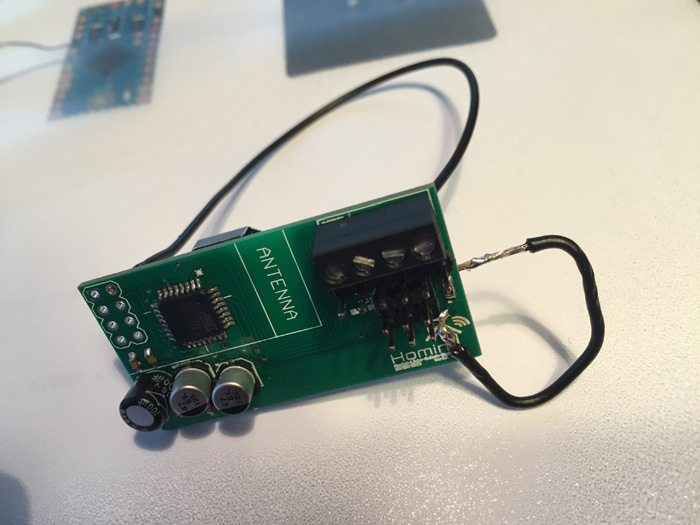
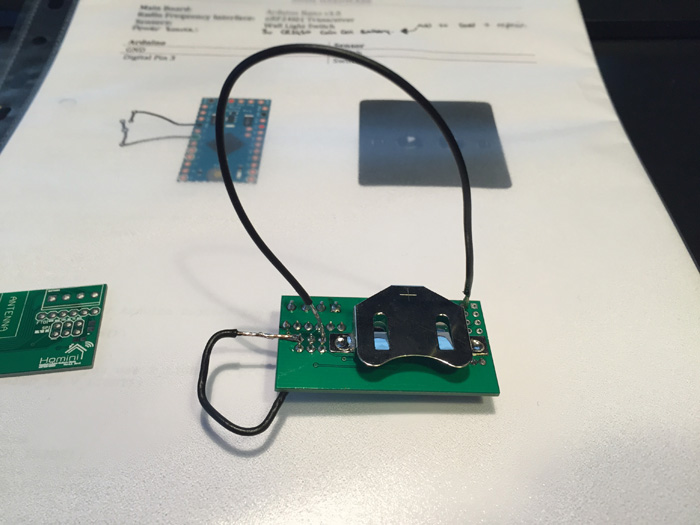
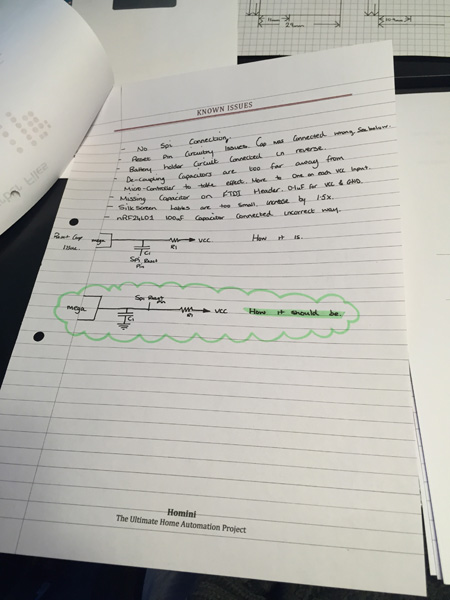
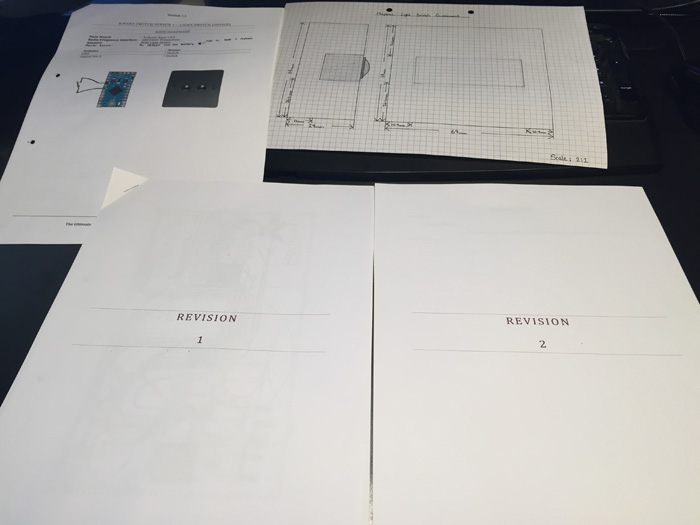
-
I would like to ask if someone could just double check my Schematic and Board layout for me, just as a second pair of eyes before i send the gerber files over to ITead.cc in the morning. I'm pretty sure everything is as it should be, but would like a second pair of eyes to give it a scan over.
Can't wait to get Rev2 up and running to deliver the upgrades that have been made!
Thank you in advance


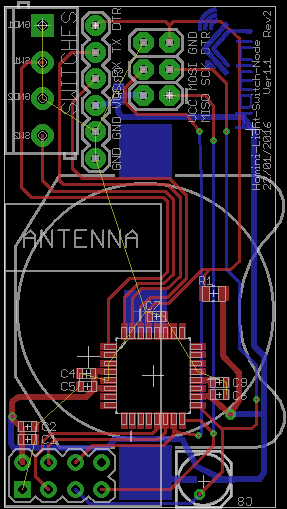
-
@samuel235 Look again at your Reset-Dtr net wiring compared to example and reference. Also C8 is probably ment to be in parallell with the battery.
-
@m26872 - I'll get that checked over tonight then. It was late last night when i finished it up. Thank you.
Just a quick bit of information released from about ITead.cc this morning:

-
@m26872 - I just have to connect the right side (positive connection) to the batt + right?
Then for the reset line, i've been having some horrible issues with understanding the connection for this and i genuinly thought i had it here with this Rev. I will study that and take a look soon as i get home today.
-
@m26872 said:
@samuel235 Look again at your Reset-Dtr net wiring compared to example and reference.
I'm sorry @m26872, however i feel that my reset line is connected correctly. I have used Atmel's recommendation to verify this and everything is exactly the same as they suggest to use apart from the fact i do not have a diode in there, which they recommend.
Also C8 is probably meant to be in parallel with the battery.
I have the negative connection made to the GND plane, then the positive receives its power from the BATT and then out to the various components now.
Below is 3 images, one for the modified BATT & C8 connection, one for the recommended reset circuit from Atmel, and the other is my actual reset circuit.
C8 & BATT
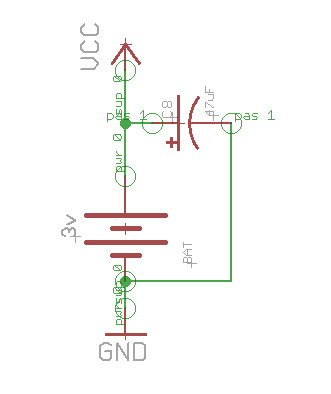
Atmel's recommendation for reset circuit
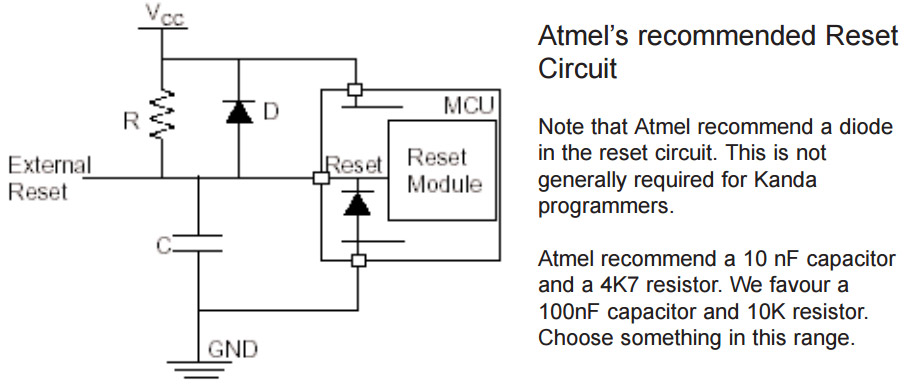
My Actual reset circuit

Please could you inform me where I am going wrong with the reset pin because I simply can't see anything to my knowledge.
-
I think you may add some net labels at RST, DTR. So it is less ambiguous to read

Here a basic sparkfun arduino mini schematic so you can check
https://cdn.sparkfun.com/assets/0/7/5/5/1/51eec304ce395f104c000000.png
-
@scalz - Labels have been added to make it easier to understand.
However, this is exactly how I wired Rev1, it didn't work until I hacked together the reset pin. I'm getting even more confused at to why my Rev1 didn't work now, I thought that by bypassing/altering the connections with some wires and it working would indicate that I had wired Rev1 incorrectly, I used the link you sent to me as reference while I was making Rev1.
However, i have done as you have suggested and attached images below. I've also attached my eagle files in case you wanted to trace any routes you can't see clearly on the images.
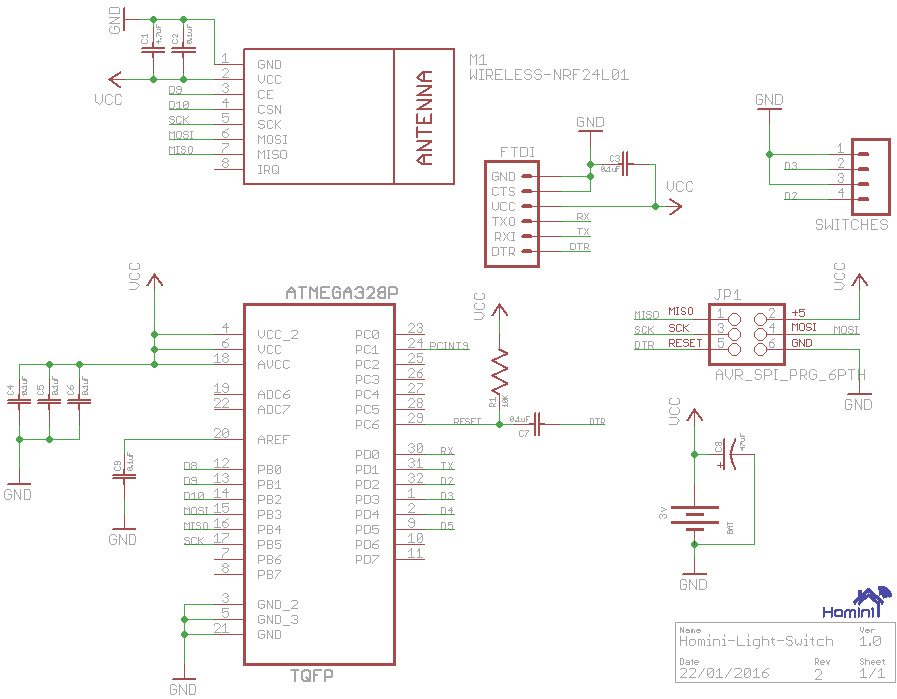
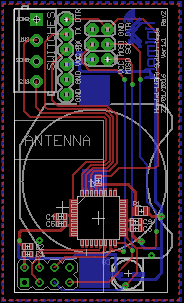
-
Looks good now except that AVR ISP (JP1) pin 5 should connect straight to RESET and not to DTR.
-
@m26872 - Does the FTDI need to go to RESET or DTR? I'm feeling DTR because all the FTDI programmers i'm using is labeled with DTR and not RESET, am i correct in assuming this?
-
@samuel235 Yes.
-
@m26872 - Perfect. Thank you for your assistance, I really appreciate it! I'll get these ordered tonight hopefully and then keep looking at the circuitry for my RESET and DTR line to memorize it and work out why its so hard to get into my brain xD.
Just one last confirm, since I'm not that confident with myself at the moment regarding this RESET line, if you don't mind.
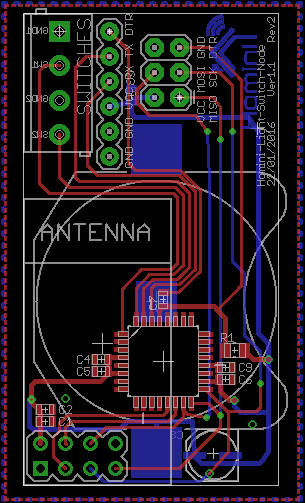
-
@samuel235 Reset and Dtr routing looks correct, but you still have DTR silkscreen label next to AVR ISP.
-
@m26872 said:
@samuel235 Reset and Dtr routing looks correct, but you still have DTR silkscreen label next to AVR ISP.
Indeed I do, the board itself isn't finished yet, I just wanted you to clarify the wiring was correct. Time to tidy it up, finish the annotating and get it finalized. However, thank you for pointing it out to me (Shows you're actually paying some attention to this). Thank you, yet again. The level of support and time you dedicate to helping others on here is outstanding. It is most certainly noticed!
-
@samuel235 You're very welcome. We'll all benefit when you succeed.
-
UPDATE!
Revision 2 boards have now been submitted for manufacturing. Standard shipping used, so expecting within the next 23 days. This is going to pain me!
On the side note, I've enrolled for Open University and will be studying now for around 4 years. I'm doing a Computing and IT degree to follow on from my existing IT Qualifications (Microsoft and CompTIA). I do hope to incorperate this community and the projects i take on with you guys into my studying. I also do not expect this to effect the time and effort I'm able to spend with you guys here and developing our projects together.
I will update you ASAP, when these boards get here

-
great

-
I will upload this device to Openhardware.io as soon as i have it built up and the basic functionality working. Hopefully then it will become much easier for the starting MySensor budding builders to understand and follow. I may do a 'basic build instructions' that can be followed on how to get this working, including putting the hardware together.
-
Board Revision2 got delivered today and obviously i set about populating the board instantly!
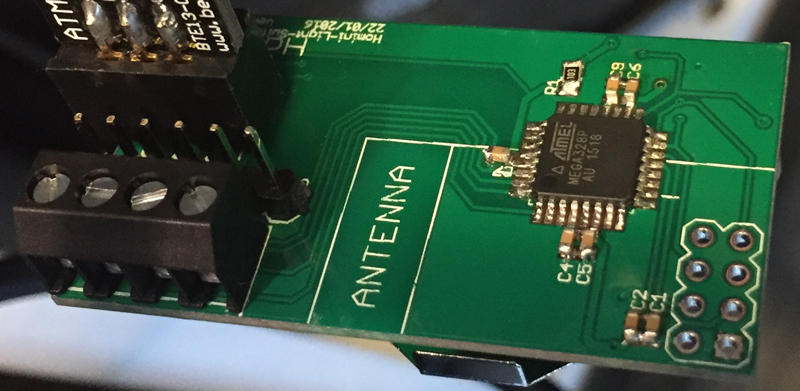
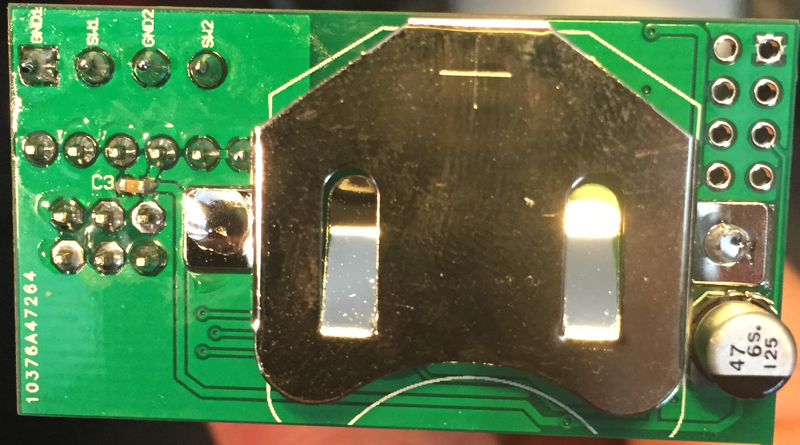
I have the board all completed and now I'm attempting to burn the bootloader on. Before i go ahead and screw my IC up (I read if you use the wrong fuse reading for the timing of the clock you can't Re-burn anything else to it) i would like some advice. I've detected the current/pre-set fuse readings through AVRDUDESS using a clock speed of 93.75KHz, so i know the connection between my computer and the board is working. The readings for the fuses are below:
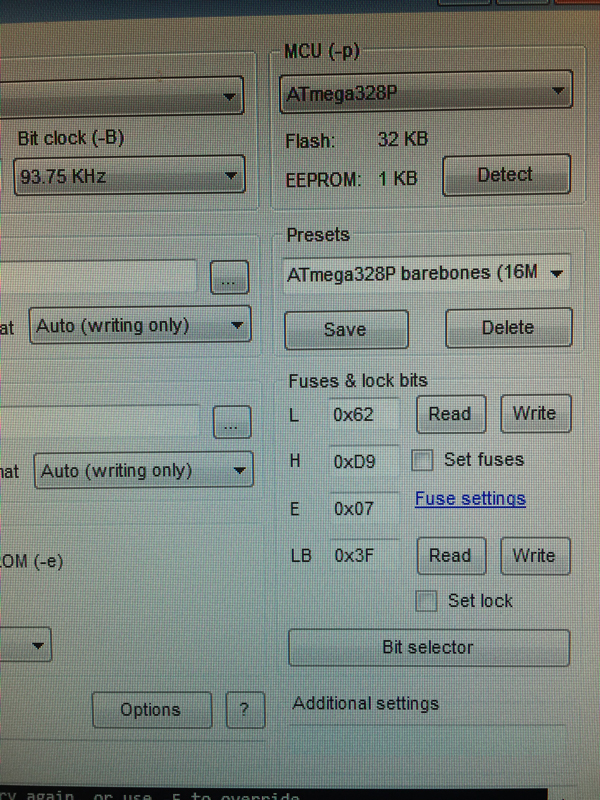
I'm currently using the fuse calculator here to workout the fuses needed. I'm also looking at Maniac's blog post here as he made a very low power module. The only thing i would question about his version/board is that his brownout is set to 2.7v. I've checked the nRF module and the lowest voltage it can go is 1.9, so maybe i should bring the BoD reading down even more or even disable it all together (I plan on reading the battery voltage from this module anyway).
The below settings for the fuses are my own workings out with the fuse calculator linked above, I'm doubting myself here, i'm in territory that i'm not comfortable with so I'm more than likely making a mistake here but what do you think? The BoD is set to 1.8 here:
Low: 0x62 | High: 0xD9 | Extended: 0xFE
Once i have confirmed a fuse setting, Do I edit them into the board.txt config of Maniac's blog post or do I use that of @tekka's?
-
I have a very brief guide here, under 'Software'. There are some links to other guides as well. I think you use (42, DE, 07/FF) together with that linked bootloader (important).
I also think Maniacs guide is a little old. You should get a a lot lower power by using MySensors lib and other some other tricks and settings.
-
@m26872 From having a quick look at your guide, you bring your clock speed right down to 1MHz, am i correct in thinking this? Do you have any timing issues at all, is the node still quick enough to respond to switching and sensor detecting or is there a delay in the signal sending?
-
@samuel235 Yes, it's working. But you can't use some things like DS18B20s and DHTs at these low frequencies. Si7021 etc are used instead. Button switches and other simple things are exellent applications.
-
@m26872 - Well, I was planning on maybe having a temp sensor in there at some point, but not this revision. So if i went without that function at the moment it wouldn't be the end of the world, i would just revise even more for the next revision. I'm presuming that you have taken it to 1MHz for power saving or?
This is the configuration i'm thinking:
######## settings for 8Mhz internal clock
proMYSBL8.name=ATmega328 internal 8Mhz with MYSBootloader
proMYSBL8.upload.tool=avrdude
proMYSBL8.upload.protocol=arduino
proMYSBL8.upload.maximum_size=30720
proMYSBL8.upload.maximum_data_size=2048
proMYSBL8.upload.speed=57600
proMYSBL8.bootloader.tool=avrdude
proMYSBL8.bootloader.low_fuses=0x42
proMYSBL8.bootloader.high_fuses=0xDE
proMYSBL8.bootloader.extended_fuses=0xFF
proMYSBL8.bootloader.unlock_bits=0x3F
proMYSBL8.bootloader.lock_bits=0x3F
proMYSBL8.bootloader.file=MySensors/MYSBootloader.hex
proMYSBL8.build.mcu=atmega328p
proMYSBL8.build.f_cpu=8000000L
proMYSBL8.build.board=AVR_UNO
proMYSBL8.build.core=arduino
proMYSBL8.build.variant=standardThat would remove the brownout, enable SPI, and put the clock to 8MHz. What is your thoughts on this config?
-
- You'll need low MHz for ot to work when battery runs out and voltage decreases.
- Those fuses are for 1MHz, not for 8MHz.
- I've never used MYSBootloader. Someone else has to confirm the settings if you use this.
-
Lower clock speed would last through the low power phase of the battery. Obviously, thank you for pointing that out! However, I'm looking at Maniacs battery testing graph and the battery is stable down to around 2.4v for around 150 hours, then it will rapidly drop off to 0v, so I'm thinking "is the lower clock speed really worth the extra 10 hours of use?".
The fuses, although I am going off of what you suggested, i entered them into my fuse calculator and its showing up at 8MHz, with no modification needed to the speed.... I'm a little confused at this part as you have now said that those fuses are for 1MHz.
I'm now wondering if its worth using MYSBootloader or the one you used, I can see that you used this and programmed through the Arduino IDE, from your post you said you're more comfortable with using the Arduino IDE (Which i am too, but can adapt if needed).
-
@samuel235: don't worry about 1mhz...there is no big difference 1Mhz vs 8Mhz at 3V in deepsleep mode. In deepsleep mode, at 3V 8Mhz internal rc, you can get 140nA. So you can't have such interesting diff.
In other hand, if node is wake up, you are in mA range, and here it can be interesting to play between clock and voltage you can do it on the fly in sketch and it's good to know that for timing things, atmel clock and voltage are linked.
you can do it on the fly in sketch and it's good to know that for timing things, atmel clock and voltage are linked.
So i would suggest you to stay with internal rc 8Mhz, BOD 1.8V and MYSBootloader. If I remember right it should be ok. Other thing good to know, you can disable BOD=0V when in deepsleepmode (this is done like this in lib I think), but it's not a good practice to disable it when wake up. Keep 1.8V limit, it can prevent some bugs..All is described in datasheet
Another thing good to know, as I see lot of peope estimation for coincell...there are lot of chance that you can't get the full coincell capacity, depending on the application, the use. A common "prevision is to plan 80% of its capacity. It's due to the rate of discharge of battery and coincell's one is small..
There are lot of others resources on the subjects but here few links :
https://www.dmcinfo.com/Portals/0/Blog Files/High pulse drain impact on CR2032 coin cell battery capacity.pdf
http://www.embedded.com/electronics-blogs/break-points/4429960/How-much-energy-can-you-really-get-from-a-coin-cell-
http://www.ti.com/lit/wp/swra349/swra349.pdf
-
@scalz This is the information that was much needed. Right, so my settings are going to be:
######## settings for 8Mhz internal clock
proMYSBL8.name=ATmega328 internal 8Mhz with MYSBootloader
proMYSBL8.upload.tool=avrdude
proMYSBL8.upload.protocol=arduino
proMYSBL8.upload.maximum_size=30720
proMYSBL8.upload.maximum_data_size=2048
proMYSBL8.upload.speed=57600
proMYSBL8.bootloader.tool=avrdude
proMYSBL8.bootloader.low_fuses=0x62
proMYSBL8.bootloader.high_fuses=0xD9
proMYSBL8.bootloader.extended_fuses=0xFE
proMYSBL8.bootloader.unlock_bits=0x3F
proMYSBL8.bootloader.lock_bits=0x3F
proMYSBL8.bootloader.file=MySensors/MYSBootloader.hex
proMYSBL8.build.mcu=atmega328p
proMYSBL8.build.f_cpu=8000000L
proMYSBL8.build.board=AVR_UNO
proMYSBL8.build.core=arduino
proMYSBL8.build.variant=standardAt the moment the fuses are set using Hexadecimal notation, I'm sure that I read somewhere that to burn this using a Arduino IDE you need to use normal binary rather than Hex. Do you know if Hex is okay for Arduino IDE?
I've got those fuses set to enable 1.8v BoD, 8MHz clock with a 65ms delay on startup. This will use MYSBootloader too. Does this sound okay to now edit my boards.txt, and burn the MYSBootloader.hex file to the chip? I'm using a USBASP device connected to my ISP connection. Am i forgetting anything at all here? As far as I'm aware of, i now plug the board and USBASP into my computer, load the .hex file into arduino IDE and burn using the board config i have put into my boards.txt file. Then i can use my FTDI adapter to then burn sketches to the board through the arduino IDE?
I know that to some people I may be asking what seems like the same questions over and over but I'm starting to feel very confident with embedded chips now. Thank you!
-
no problem
 yes, it sounds ok...that's how I do too. But I don't use mysbootloader, i use dualoptiboot (sensebender bootloader). for the hex/bin fuse notation, I use hexa.
yes, it sounds ok...that's how I do too. But I don't use mysbootloader, i use dualoptiboot (sensebender bootloader). for the hex/bin fuse notation, I use hexa.
-
- You could be rigth regarding the battery. I've no coin cell experience.
- You noticed the check mark by the 'divide clock by 8' ?
- If you by 'program' normal ftdi flash, then yes. I didn't program bootloader with Arduino.
-
Is there a reason to use dualoptiboot over MYSBootloader or is that just something you did for no reason?
Did you use Arduino IDE to burn your bootloader, if so then i can confirm its okay to use Hexa for my board with arduino IDE, if you didn't i will have to convert it to normal binary.
I have just realised that you burn your bootloader with the check mark of 8MHz but then the board.txt is configured to set it to 1MHz, is that what you're trying to tell me? I'm not too sure on your last point, i don't get what you're trying to say if i'm honest, could you elaborate a little? Sorry.
-
@samuel235: yes, always good reasons
 I have tried both. both works well. I like the "buffer style" of dualoptiboot. plus no mysensors lib in bootloader, few others reasons...but mysbootloader is very cool too and simple. So don't worry about this
I have tried both. both works well. I like the "buffer style" of dualoptiboot. plus no mysensors lib in bootloader, few others reasons...but mysbootloader is very cool too and simple. So don't worry about this  it's a matter of taste, each have their pros&cons.
it's a matter of taste, each have their pros&cons.
Yes, use arduino ide to burn bootloader + hexa is ok.
-
@scalz - Perfect. I will see how i get on with the MYSBootloader style. Soon as i get back i will burn these settings to my uC and see how i get on. I will come back with the results when i'm done.

-
- Don't know if good practice or not, but I run 328p + nRF down to 1.6V very stable. Could depend on a lot things and conditions of course. You said "some bugs" - do you know more what risks there are? Permanent damages etc?
- Do you know if the 'Divide clock by 8" (8MHz or 1MHz) also can be changed on-fly-with code? If so, does it matter which speed set by fuse and thus used at start-up?
- Great thanks for the coin cell info!
-
@samuel235 I meant that you should untick this to use 8MHz. Provided that you don't change it on-the-fly somehow.
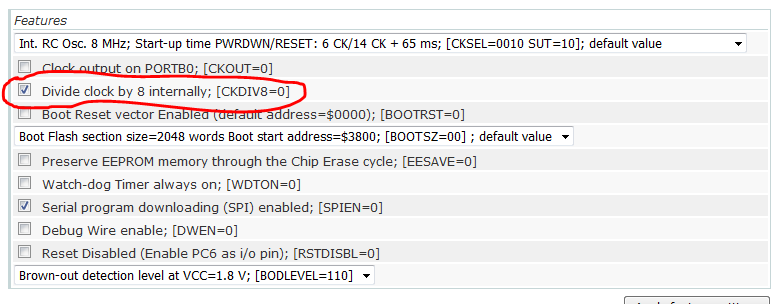
-
@samuel235 Sorry for not elaborating. I've been mobile all day until now. And my phone also seems to have a few issues with the forum.
-
@m26872 Ahh right okay, good job i caught your reply before burning it haha! So if i set it to 8MHz internal with 64ms delay and untick that divide by 8 option, that'll be good?
-
Yes. but don't forget to enable the boot reset vector.
-
@samuel235 I have not checked if the bootloader size and baud rate matches fuse settings.
-
- for bod=0v, problems could be flash corruption for instance..so it's good to know (it's explained in datasheet that for instance it ensures that a flash write is completely done before reset, I think it makes sense, plus I imagine that there are some internal things with voltage levels related stuff. but I'm not a guru on this....). So my interpretation is sometimes we don't care about it for sleepmode, for instance, and sometimes in wakeup, it's important or not, depending of tasks involved...
maybe I should have said a good practice is to know what you do, lol! - for prescaler, are you asking for something like this : http://www.gammon.com.au/forum/?id=11497&reply=7#reply7
- glad to share what I learn

- for bod=0v, problems could be flash corruption for instance..so it's good to know (it's explained in datasheet that for instance it ensures that a flash write is completely done before reset, I think it makes sense, plus I imagine that there are some internal things with voltage levels related stuff. but I'm not a guru on this....). So my interpretation is sometimes we don't care about it for sleepmode, for instance, and sometimes in wakeup, it's important or not, depending of tasks involved...
-
@scalz .
maybe I should have said a good practice is to know what you do, lol!
l don't fulfil that either, lol!

Thanks for the prescaler info. Seems like a yes - it can be changed on-the-fly, but for me it's a No. I won't even dare to think of consequences for the rest of the software.
-
@m26872 said:
@samuel235 I have not checked if the bootloader size and baud rate matches fuse settings.
I'm not 100% sure of what you mean here, on the fuse calculator there is not an option to specify the baud rate.... As for the bootloader size, the calculator is set to "Boot Flash section size=2048 words Boot start address=$3800; [BOOTSZ=00]". As this is the highest it can be I'm assuming it is correct, however i will try and check the size of the MYSBootloader.hex size and see if it is below 2048 words (Is this what this setting means?).
-
@samuel235 No, but bootloader and boards.txt must have same buad rate. I think you already have the correct though since 8MHz is pretty much standard clock speed. Slower clock would require lower buad rate.
-
@m26872 Is there a way to read the .hex file to see the specified baud rate before i go and brick the chip? Also, just to confirm, i have to burn the fuse settings in AVRDUDE then burn the bootloader with arduino IDE. Is there anything I'm failing to understand, i only have one more uC here at the moment and i don't want to brick several of them

-
@samuel235 Sorry, I can't help you further. I don't know for sure about these things.
-
@m26872 - That is okay, I think I'm pretty safe to assume that it is correct as it is what is provided on Tekka's guide. So I'm going to attempt to burn the fuses at E2 D8 FE. Once I've done that (and it works fine), Arduino IDE should burn the bootloader onto the uC without an issue and then i can just upload a arduino sketch, right? o.O
-
I've just written the fuse settings and got this log report:
avrdude.exe: set SCK frequency to 187500 Hz avrdude.exe: AVR device initialized and ready to accept instructions Reading | ################################################## | 100% -0.00s avrdude.exe: Device signature = 0x1e950f avrdude.exe: reading input file "0xE2" avrdude.exe: writing lfuse (1 bytes): Writing | ################################################## | 100% -0.00s avrdude.exe: 1 bytes of lfuse written avrdude.exe: verifying lfuse memory against 0xE2: avrdude.exe: load data lfuse data from input file 0xE2: avrdude.exe: input file 0xE2 contains 1 bytes avrdude.exe: reading on-chip lfuse data: Reading | ################################################## | 100% -0.00s avrdude.exe: verifying ... avrdude.exe: 1 bytes of lfuse verified avrdude.exe: reading input file "0xD8" avrdude.exe: writing hfuse (1 bytes): Writing | ################################################## | 100% 0.02s avrdude.exe: 1 bytes of hfuse written avrdude.exe: verifying hfuse memory against 0xD8: avrdude.exe: load data hfuse data from input file 0xD8: avrdude.exe: input file 0xD8 contains 1 bytes avrdude.exe: reading on-chip hfuse data: Reading | ################################################## | 100% 0.00s avrdude.exe: verifying ... avrdude.exe: 1 bytes of hfuse verified avrdude.exe: reading input file "0xFE" avrdude.exe: writing efuse (1 bytes): Writing | ***failed; ################################################## | 100% 0.09s avrdude.exe: 1 bytes of efuse written avrdude.exe: verifying efuse memory against 0xFE: avrdude.exe: load data efuse data from input file 0xFE: avrdude.exe: input file 0xFE contains 1 bytes avrdude.exe: reading on-chip efuse data: Reading | ################################################## | 100% 0.00s avrdude.exe: verifying ... avrdude.exe: verification error, first mismatch at byte 0x0000 0x06 != 0xfe avrdude.exe: verification error; content mismatch avrdude.exe done. Thank you.I then checked the fuses by reading them. I can confirm it has written the Low and the High fuse but as the log says, it failed to write the extended. So I went to the calculator site and read the following (This is what i was asking about hex vs binary for):
"Note that some numerical values refer to fuses containing undefined bits (set to '1' here). Depending on the target device these fuse bits will be read either as '0' or '1'. Verification errors will occur if the values are read back with undefined bits set to '0'. Everything is fine if the values read from the device are either the same as programmed, or the following values (undefined set to '0'): Extended: 0x06."
I then attempted to burn the bootloader, assuming the error is fine to skip (as the fuse calculator said), but it gave me the same error of:
avrdude: verification error, first mismatch at byte 0x0000 0x06 != 0xfe avrdude: verification error; content mismatchSo basically, telling me that my boards.txt is telling the IDE that the fuse should be FE, but its 06.
-
Looks like ext fuse is already 0x06 and you only need to change your board.txt to the same. I've never heard before that the 0xFE type of writing should work in avrdude/Arduino IDE.
-
I went ahead and changed my board.txt to reflect 0x06, to check. It passed through and burnt the bootloader. However, if i try to upload a sketch (using the FTDI adapter that i have, this) I get a timing error. How do i upload a sketch to the chip with the ISP connection (just to test if my FTDI pins are wired incorrectly). This is my log from arduino IDE:
Sketch uses 12,610 bytes (41%) of program storage space. Maximum is 30,720 bytes. Global variables use 398 bytes (19%) of dynamic memory, leaving 1,650 bytes for local variables. Maximum is 2,048 bytes. avrdude: stk500_recv(): programmer is not responding avrdude: stk500_getsync() attempt 1 of 10: not in sync: resp=0x7c avrdude: stk500_recv(): programmer is not responding avrdude: stk500_getsync() attempt 2 of 10: not in sync: resp=0x7c avrdude: stk500_recv(): programmer is not responding avrdude: stk500_getsync() attempt 3 of 10: not in sync: resp=0x7c avrdude: stk500_recv(): programmer is not responding avrdude: stk500_getsync() attempt 4 of 10: not in sync: resp=0x7c avrdude: stk500_recv(): programmer is not responding avrdude: stk500_getsync() attempt 5 of 10: not in sync: resp=0x7c avrdude: stk500_recv(): programmer is not responding avrdude: stk500_getsync() attempt 6 of 10: not in sync: resp=0x7c avrdude: stk500_recv(): programmer is not responding avrdude: stk500_getsync() attempt 7 of 10: not in sync: resp=0x7c avrdude: stk500_recv(): programmer is not responding avrdude: stk500_getsync() attempt 8 of 10: not in sync: resp=0x7c avrdude: stk500_recv(): programmer is not responding avrdude: stk500_getsync() attempt 9 of 10: not in sync: resp=0x7c avrdude: stk500_recv(): programmer is not responding avrdude: stk500_getsync() attempt 10 of 10: not in sync: resp=0x7c Problem uploading to board. See http://www.arduino.cc/en/Guide/Troubleshooting#upload for suggestions."programmer is not responding" - I was asking myself "Would this mean that arduino IDE can't use avrdude for some reason?" but then i figured that it used it to burn the bootloader so that isnt right. Is it trying to find the ISP programmer and cant because i'm connected through FTDI maybe?
-
I have just remembered that if you go to the file menu in Arduino IDE you get the option to upload using programmer. I have just done this through my SPI programmer, it has uploaded correctly. I will now solder the nRF module onto the board and i will report back with my results. Crosses fingers
-
BINGO!!
We have a working coin cell powered light switch.

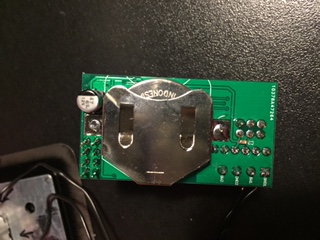

I will upload some decent images later on tonight or tomorrow.
I'de just like to talk everyone that has contributed to this thread/post and enabled me to create my first of many embedded projects. I'm applying for a University course in september for Computer Science (Smart Technologies), all about embedded systems, drones, home automation etc etc. This is just the beginning!
I'll get this project up on OpenHardware.io asap as Version 1 and we can build on this as a base plate for futher projects.
-
Now, the next two steps I'm interested in taking is to get this working with 2 switches (Software modification, should be simple) and then to have it report its remaining power every 30 minutes to allow me to set up notifications through openhab to alert me to change the batteries so I'm not left with no light switch.
-
It would appear that I'm having a timing issue with uploading via the FTDI adapter. Would this be down to the speed of the uC effecting the RX and TX connections?
-
This post is deleted!
-
@samuel235 Are you trying to upload with Ftdi serial to MYSbootloader? I think it's only for OTA uploads, if you read here.
-
@m26872 - Thank you for pointing this out to me. I'm unsure why I haven't stumbled across that thread/topic today of all days, been searching and reading about MYSBootloader all day >.<
From personal experience, would you advise any other bootloader, I'm guessing you're going to tell me about the one you are using. Could you link any information for me to check out regarding your choice of bootloader?
Am I correct in recalling you're using DualOptiBoot?
Does DualOptiBoot need external memory/flash?
-
@samuel235 No, I use plain optiboot, but I couldn't find a suiteable precompiled one for you. DualOptiboot requires external flash as you say.
It's been a while since I played with bootloaders, but I think normal 8MHz Arduino Pro Mini bootloader would work for you with internal clock as well. It's this [ATmegaBOOT_168_atmega328_pro_8MHz.hex ] and I can find it in my "C:\Program Files\Arduino\hardware\arduino\avr\bootloaders\atmega" -folder, should be about the same for you I think. Try fuse settings E2-DA-06 (Lo-Hi-Ex) and rest of the boards.txt-settings from ArduinoProMini 3.3V 8MHz.